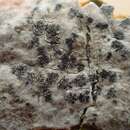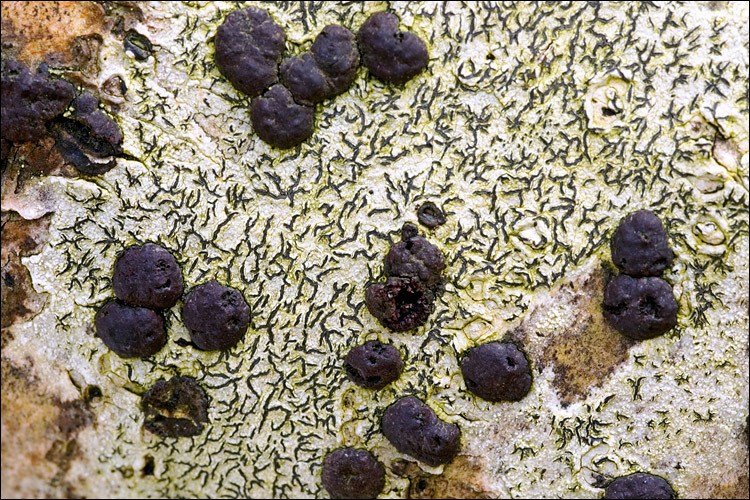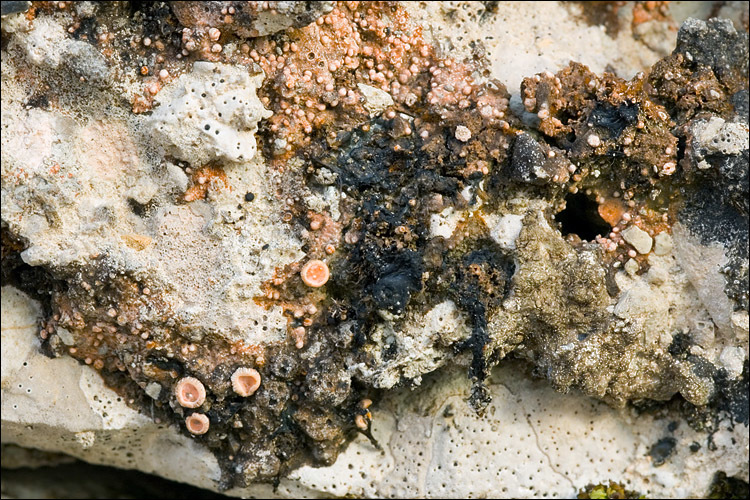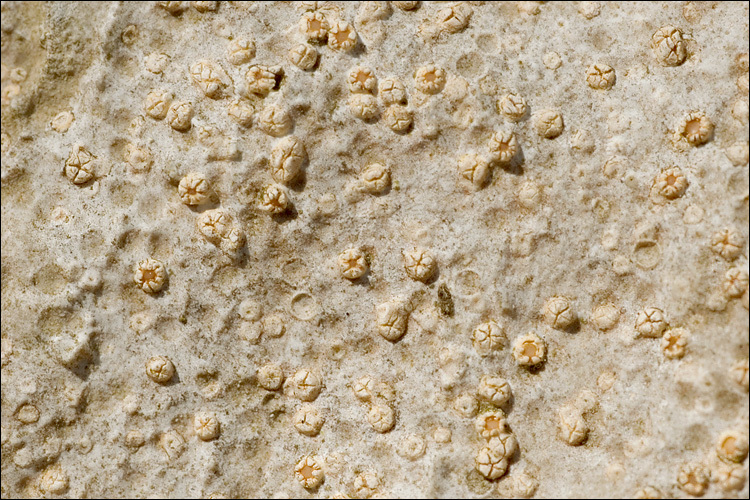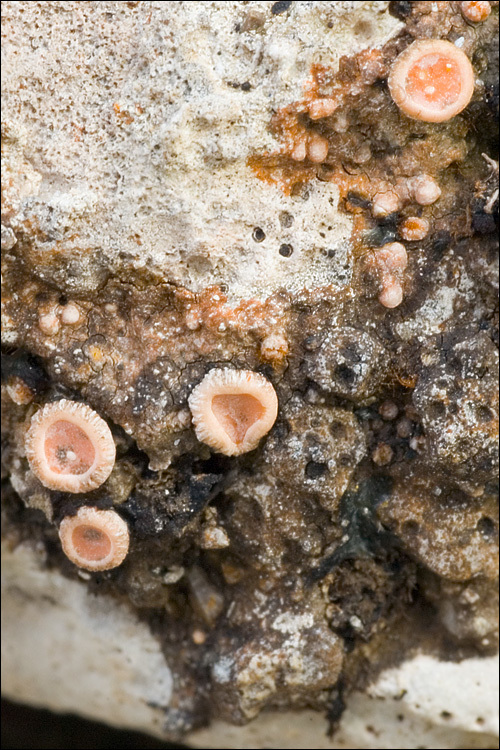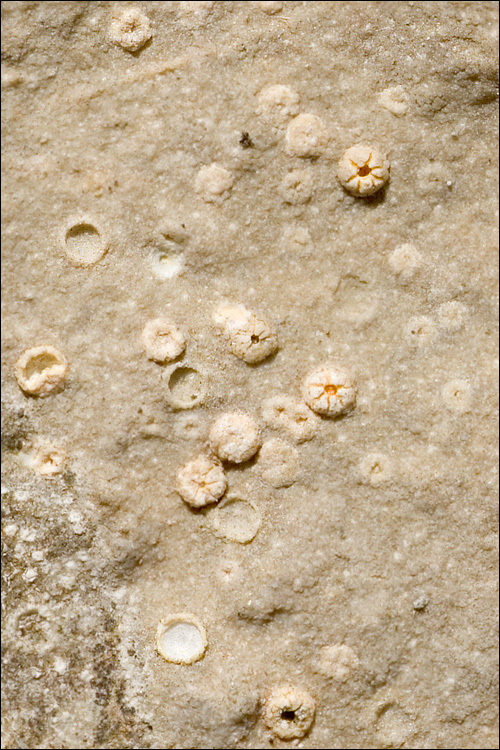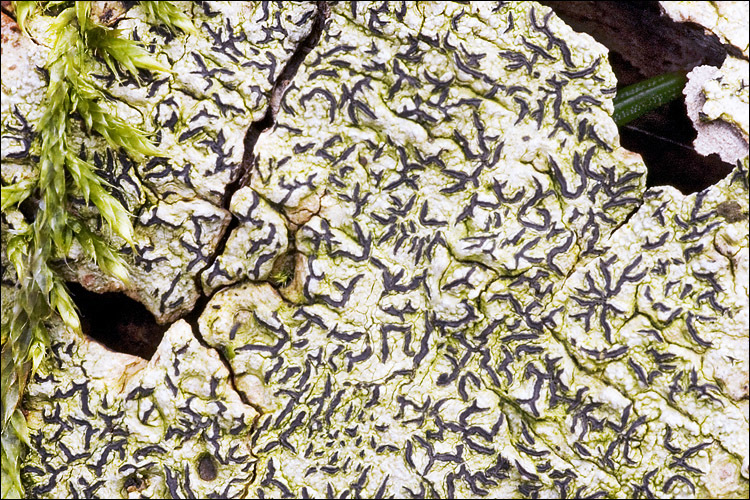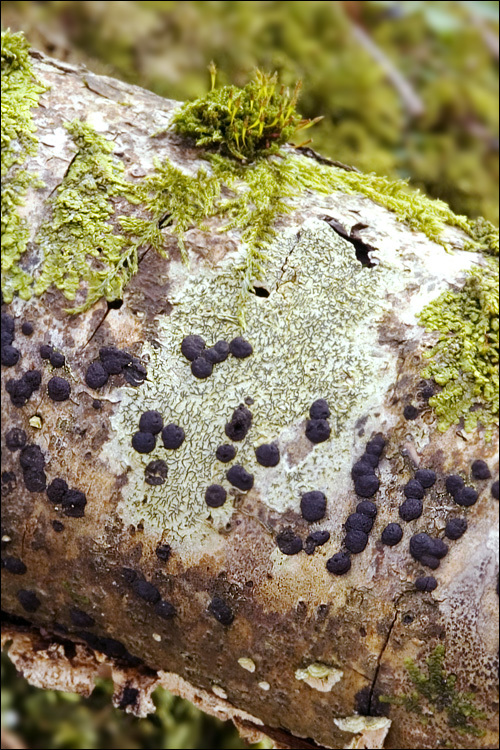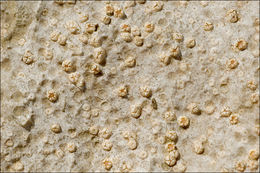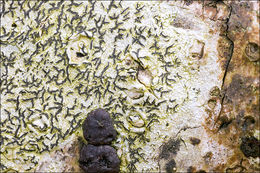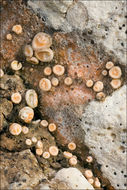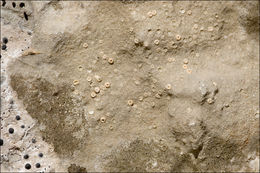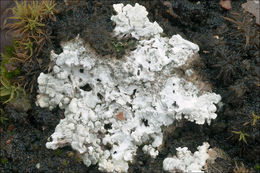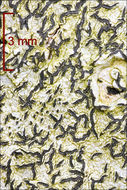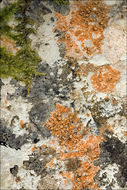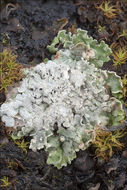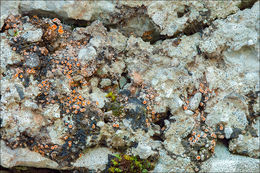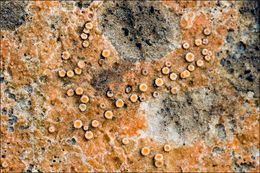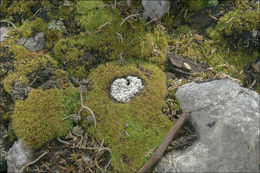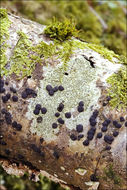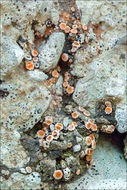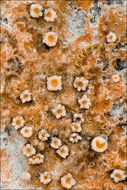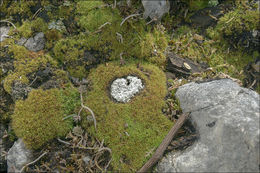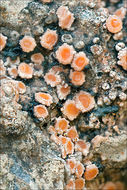-
Slo.: ? - Habitat: Mixed wood, near a stream, humid and shaded place, protected from direct rain by tree canopies, precipitations ~3.000 mm/year, average temperature 7-9 deg C, elevation 630 m (2.100 feet), alpine phytogeographical region. Substratum: Bark of a fallen trunk of Fagus sylvatica
-
Slo.: - ? - Habitat: Stony wall of a bridge across a water stream, 2 m (6 feet) above water level, N faced, humid and shady place, precipitations 3.000 mm/year, average temperature 8-10 deg C, altitude 450 m (1.500 feet), alpine phytogeographical region. Substratum: vertical and over hanged calcareous rock
-
Slo.: ? - Habitat: Wood-side, mixed forest/cultivated grassland, vertical side of the boulder SE exposed, precipitations ~3.000 mm/year, partly shady, fully exposed to rain, average temperatures 8- 10 deg C, altitude 480 m (1.600 feet) alpine phytogeographical region. Substratum: bare limestone boulder
-
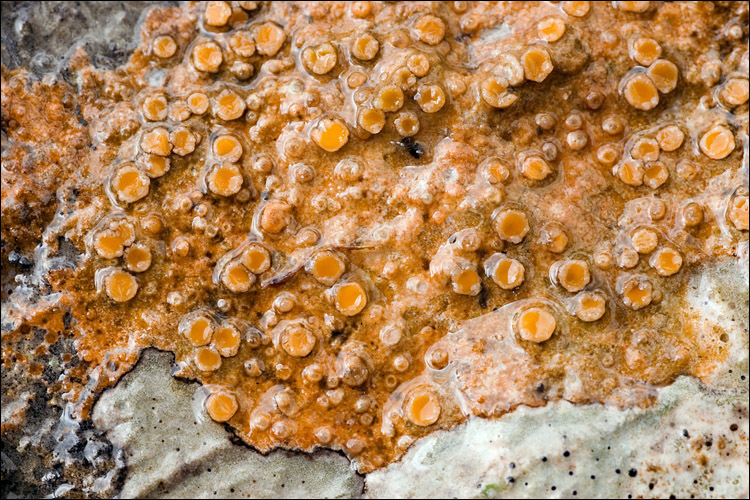
Soaked wet conditions. Eventually Gyalecta leucaspis? According to Wirth a very rare species for Germany. Pruegger et all. 'Alphabetical list of lichenized fungi for the six phytogeographical regions of Slovenia' has this species listed. G. leucaspis has vividly pink to light orange thallus and its apothecia rim disintegrate into 5-10 radial sections when old (Wirth, 1995). This corresponds well to my pictures. However, I can not find thick gray-white pruina on apothecia which is also a typical character for G. leucapsis. On the other hand, in literature and on web I have never found mentioning vivid orange as a possible thallus color of G. jenensis. G. jenensis is quite common here and also a possibility. Observing spores would resolve the dilemma. Habitat: Road scarp rocks of a dirt road, humid shady place, mixed forest and grassland around, no insolation during winter months, often wet, north oriented, 1.5 mm off the road level, exposed to precipitations, precipitations ~3.000 mm/year, average temperature 7-9 deg C, elevation 400 m (1.300 feet), alpine phytogeographical region. Substratum: vertical calcareous rock surface. Ref.: http://members.chello.at/johannes.pruegger/uni/slovenia/ , Wirth, (1995), Die Flechten Baden-Wuerttembergs, Ulmer, Vol.1., p410, Brodo, Sharnoff, Sharnoff (2001), Lichens of North Ameria, Yale Uni.Press, p329.
-
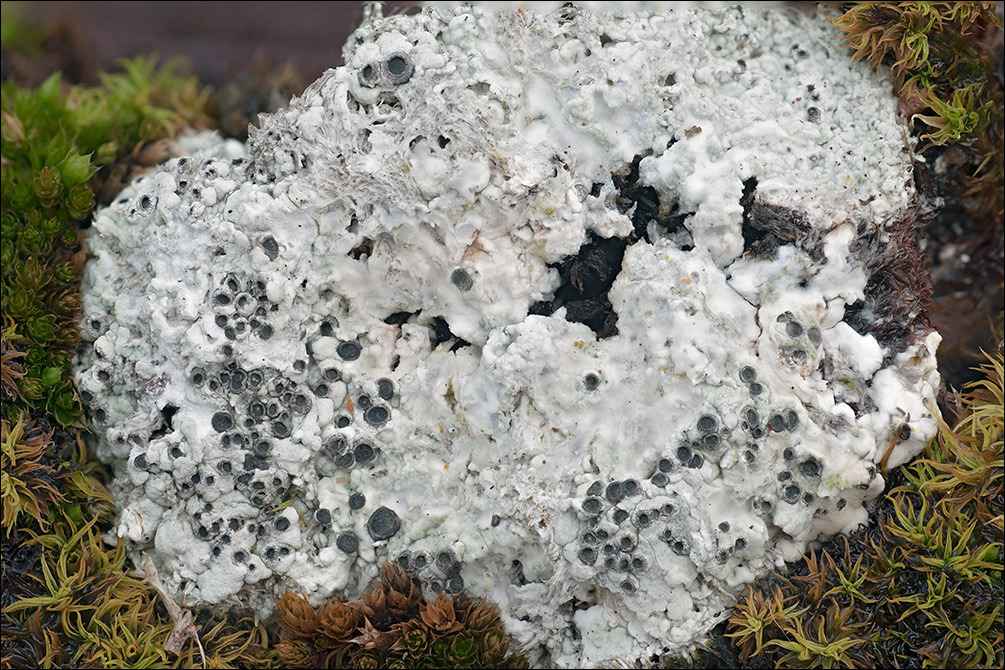
Slo.: ? - syn.: Diploschistes bryophilus f. parasitica (Sommerf.) Servt, Diploschistes lichenicola (Mont. & Fr.) Vain., Diploschistes scruposus f. bryophilus (Ehrh.) Oxner, Urceolaria scruposa f. parasitica (Sommerf.) Arnold - Habitat: Slightly inclined mountain slope, south aspect; a patch of stony grassland surrounded by trees and bushes (former pastures), Ostrya carpinifolia and Corylus avellana dominant; calcareous, skeletal, colluvial ground; full sun, relatively warm, dry and open place; exposed to direct rain; average precipitations ~ 3.000 mm/year, average temperature 7-9 deg C, elevations 615 m (2.020 feet), alpine phytogeographical region. Substratum: on thallus and podetia of Cladonia cf. pocillum, soil and mosses. Comment: Diploschistes muscorum is an interesting, cosmopolitan lichen living on ground. When young it parasitizes other lichens of Cladonia pyxidata group (Wirth 1995), especially Cladonia rangiformis and Cladonia pocillum (Dobson 2005). In this observation the host seems to be Cladonia pocillum. It gradually incorporates the algae of the host in its own thallus (Brodo 2001) and thus kill it. When mature it becomes free-living on mosses and ground without help of parasitism. It can grow to considerable sizes. This observation shows small, young specimens, max a few cm in diameter. Picture 3 shows a young specimen just becoming fertile, where lowest, outer squamules of the host are still alive and green. Picture 5c shows a podetium of the host thinly overgrown with Diploschistes muscorum thallus. Picture 2 shows an older specimen where no parts of the host can be seen directly, however, the shape of the thallus still resembles to some extent original shape of the Cladonia squamules. Later there is no more resemblance on Cladonia. Growing scattered. Several specimens found in the vicinity. Chemical reaction on thallus K-. Photographed in damp conditions.Ref.:(1) V. Wirth, Die Flechten Baden-Wrttembergs, Teil.1., Ulmer (1995), p 379.(2) I.M. Brodo, S.D. Sharnoff, S.Sharnoff, Lichens of North America, Yale Uni. Press (2001), p 304.(3) http://lichenportal.org/portal/taxa/index.php?taxon=52885 (accessed March 20. 2018) (4) F.S. Dobson, Lichens, The Richmonds Publishing Ca.LTD (2005), p 166.(5) C.W.Smith, et all, The lichens of Great Britain and Ireland,The British Lichen Society,(2009), p 380.(6) P.L. Nimis, Image archive of ITALIC, Dryades Project http://dbiodbs.units.it/carso/chiavi_pub52 (accessed March 20. 2018)
-
Slo.: ? - Habitat: Mixed wood, near a stream, humid and shaded place, protected from direct rain by tree canopies, precipitations ~3.000 mm/year, average temperature 7-9 deg C, elevation 630 m (2.100 feet), alpine phytogeographical region. Substratum: Bark of a fallen trunk of Fagus sylvatica
-
Slo.: - ? - Habitat: Stony wall of a bridge across a water stream, 2 m (6 feet) above water level, N faced, humid and shady place, precipitations 3.000 mm/year, average temperature 8-10 deg C, altitude 450 m (1.500 feet), alpine phytogeographical region. Substratum: vertical and over hanged calcareous rock
-
Slo.: ? - Habitat: Wood-side, mixed forest/cultivated grassland, vertical side of the boulder SE exposed, precipitations ~3.000 mm/year, partly shady, fully exposed to rain, average temperatures 8- 10 deg C, altitude 480 m (1.600 feet) alpine phytogeographical region. Substratum: bare limestone boulder
-
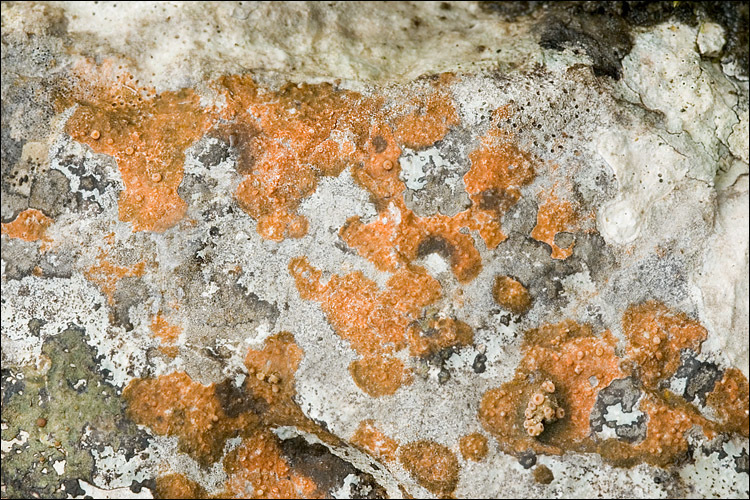
Soaked wet conditions. Eventually Gyalecta leucaspis? According to Wirth a very rare species for Germany. Pruegger et all. 'Alphabetical list of lichenized fungi for the six phytogeographical regions of Slovenia' has this species listed. G. leucaspis has vividly pink to light orange thallus and its apothecia rim disintegrate into 5-10 radial sections when old (Wirth, 1995). This corresponds well to my pictures. However, I can not find thick gray-white pruina on apothecia which is also a typical character for G. leucapsis. On the other hand, in literature and on web I have never found mentioning vivid orange as a possible thallus color of G. jenensis. G. jenensis is quite common here and also a possibility. Observing spores would resolve the dilemma. Habitat: Road scarp rocks of a dirt road, humid shady place, mixed forest and grassland around, no insolation during winter months, often wet, north oriented, 1.5 mm off the road level, exposed to precipitations, precipitations ~3.000 mm/year, average temperature 7-9 deg C, elevation 400 m (1.300 feet), alpine phytogeographical region. Substratum: vertical calcareous rock surface. Ref.: http://members.chello.at/johannes.pruegger/uni/slovenia/ , Wirth, (1995), Die Flechten Baden-Wuerttembergs, Ulmer, Vol.1., p410, Brodo, Sharnoff, Sharnoff (2001), Lichens of North Ameria, Yale Uni.Press, p329.
-
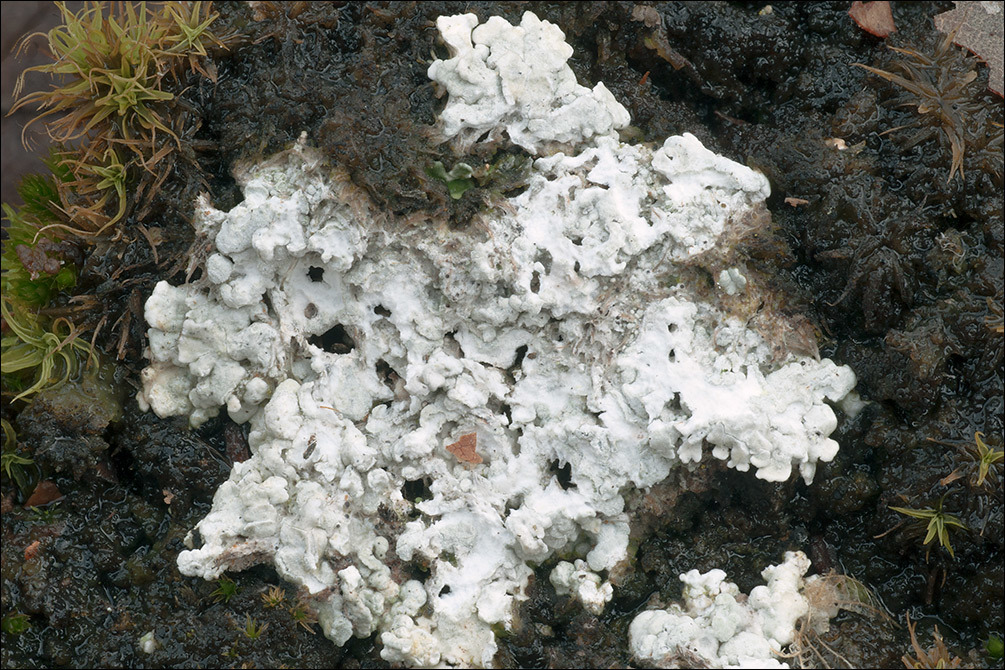
Slo.: ? - syn.: Diploschistes bryophilus f. parasitica (Sommerf.) Servt, Diploschistes lichenicola (Mont. & Fr.) Vain., Diploschistes scruposus f. bryophilus (Ehrh.) Oxner, Urceolaria scruposa f. parasitica (Sommerf.) Arnold - Habitat: Slightly inclined mountain slope, south aspect; a patch of stony grassland surrounded by trees and bushes (former pastures), Ostrya carpinifolia and Corylus avellana dominant; calcareous, skeletal, colluvial ground; full sun, relatively warm, dry and open place; exposed to direct rain; average precipitations ~ 3.000 mm/year, average temperature 7-9 deg C, elevations 615 m (2.020 feet), alpine phytogeographical region. Substratum: on thallus and podetia of Cladonia cf. pocillum, soil and mosses. Comment: Diploschistes muscorum is an interesting, cosmopolitan lichen living on ground. When young it parasitizes other lichens of Cladonia pyxidata group (Wirth 1995), especially Cladonia rangiformis and Cladonia pocillum (Dobson 2005). In this observation the host seems to be Cladonia pocillum. It gradually incorporates the algae of the host in its own thallus (Brodo 2001) and thus kill it. When mature it becomes free-living on mosses and ground without help of parasitism. It can grow to considerable sizes. This observation shows small, young specimens, max a few cm in diameter. Picture 3 shows a young specimen just becoming fertile, where lowest, outer squamules of the host are still alive and green. Picture 5c shows a podetium of the host thinly overgrown with Diploschistes muscorum thallus. Picture 2 shows an older specimen where no parts of the host can be seen directly, however, the shape of the thallus still resembles to some extent original shape of the Cladonia squamules. Later there is no more resemblance on Cladonia. Growing scattered. Several specimens found in the vicinity. Chemical reaction on thallus K-. Photographed in damp conditions. Ref.: (1) V. Wirth, Die Flechten Baden-Wrttembergs, Teil.1., Ulmer (1995), p 379. (2) I.M. Brodo, S.D. Sharnoff, S.Sharnoff, Lichens of North America, Yale Uni. Press (2001), p 304. (3) http://lichenportal.org/portal/taxa/index.php?taxon=52885 (accessed March 20. 2018) (4) F.S. Dobson, Lichens, The Richmonds Publishing Ca.LTD (2005), p 166. (5) C.W.Smith, et all, The lichens of Great Britain and Ireland,The British Lichen Society,(2009), p 380. (6) P.L. Nimis, Image archive of ITALIC, Dryades Project http://dbiodbs.units.it/carso/chiavi_pub52 (accessed March 20. 2018)
-
Slo.: ? - Habitat: Mixed wood, near a stream, humid and shaded place, protected from direct rain by tree canopies, precipitations ~3.000 mm/year, average temperature 7-9 deg C, elevation 630 m (2.100 feet), alpine phytogeographical region. Substratum: Bark of a fallen trunk of Fagus sylvatica
-
Slo.: - ? - Habitat: Stony wall of a bridge across a water stream, 2 m (6 feet) above water level, N faced, humid and shady place, precipitations 3.000 mm/year, average temperature 8-10 deg C, altitude 450 m (1.500 feet), alpine phytogeographical region. Substratum: vertical and over hanged calcareous rock
-
Slo.: ? - Habitat: Wood-side, mixed forest/cultivated grassland, vertical side of the boulder SE exposed, precipitations ~3.000 mm/year, partly shady, fully exposed to rain, average temperatures 8- 10 deg C, altitude 480 m (1.600 feet) alpine phytogeographical region. Substratum: bare limestone boulder
-
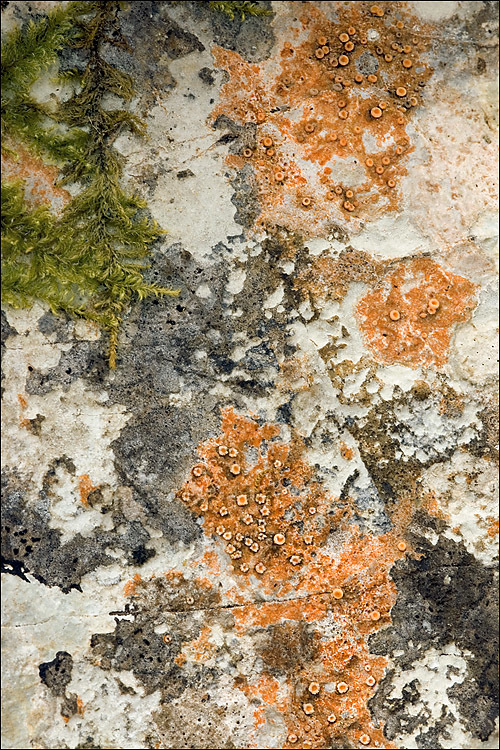
Half dry conditions. Eventually Gyalecta leucaspis? According to Wirth a very rare species for Germany. Pruegger et all. 'Alphabetical list of lichenized fungi for the six phytogeographical regions of Slovenia' has this species listed. G. leucaspis has vividly pink to light orange thallus and its apothecia rim disintegrate into 5-10 radial sections when old (Wirth, 1995). This corresponds well to my pictures. However, I can not find thick gray-white pruina on apothecia which is also a typical character for G. leucapsis. On the other hand, in literature and on web I have never found mentioning vivid orange as a possible thallus color of G. jenensis. G. jenensis is quite common here and also a possibility. Observing spores would resolve the dilemma. Habitat: Road scarp rocks of a dirt road, humid shady place, mixed forest and grassland around, no insolation during winter months, often wet, north oriented, 1.5 mm off the road level, exposed to precipitations, precipitations ~3.000 mm/year, average temperature 7-9 deg C, elevation 400 m (1.300 feet), alpine phytogeographical region. Substratum: vertical calcareous rock surface. Ref.: http://members.chello.at/johannes.pruegger/uni/slovenia/ , Wirth, (1995), Die Flechten Baden-Wuerttembergs, Ulmer, Vol.1., p410, Brodo, Sharnoff, Sharnoff (2001), Lichens of North Ameria, Yale Uni.Press, p329.
-
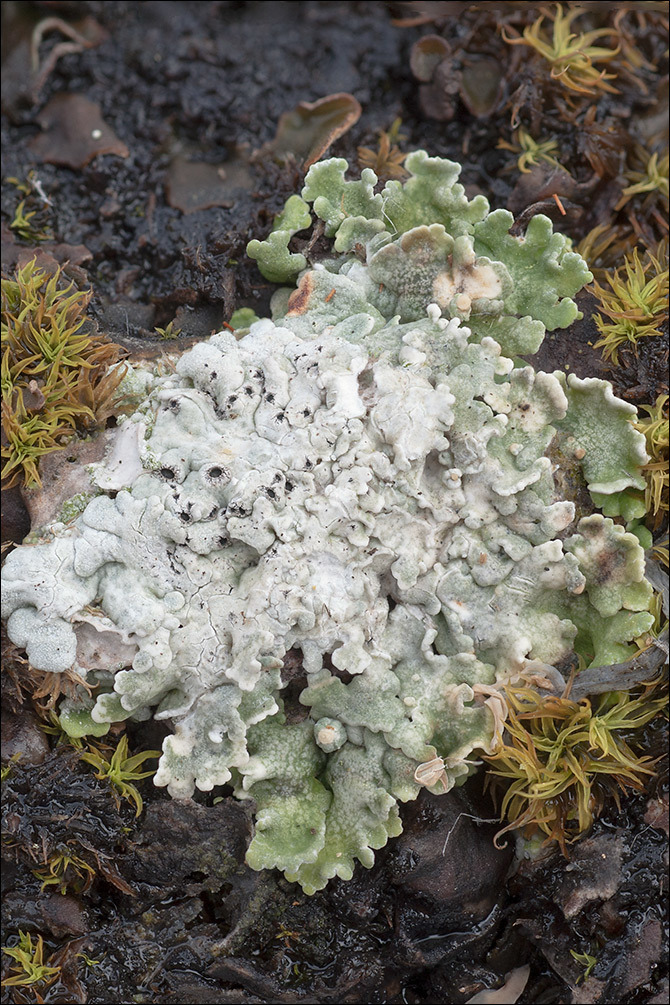
Slo.: ? - syn.: Diploschistes bryophilus f. parasitica (Sommerf.) Servt, Diploschistes lichenicola (Mont. & Fr.) Vain., Diploschistes scruposus f. bryophilus (Ehrh.) Oxner, Urceolaria scruposa f. parasitica (Sommerf.) Arnold - Habitat: Slightly inclined mountain slope, south aspect; a patch of stony grassland surrounded by trees and bushes (former pastures), Ostrya carpinifolia and Corylus avellana dominant; calcareous, skeletal, colluvial ground; full sun, relatively warm, dry and open place; exposed to direct rain; average precipitations ~ 3.000 mm/year, average temperature 7-9 deg C, elevations 615 m (2.020 feet), alpine phytogeographical region. Substratum: on thallus and podetia of Cladonia cf. pocillum, soil and mosses. Comment: Diploschistes muscorum is an interesting, cosmopolitan lichen living on ground. When young it parasitizes other lichens of Cladonia pyxidata group (Wirth 1995), especially Cladonia rangiformis and Cladonia pocillum (Dobson 2005). In this observation the host seems to be Cladonia pocillum. It gradually incorporates the algae of the host in its own thallus (Brodo 2001) and thus kill it. When mature it becomes free-living on mosses and ground without help of parasitism. It can grow to considerable sizes. This observation shows small, young specimens, max a few cm in diameter. Picture 3 shows a young specimen just becoming fertile, where lowest, outer squamules of the host are still alive and green. Picture 5c shows a podetium of the host thinly overgrown with Diploschistes muscorum thallus. Picture 2 shows an older specimen where no parts of the host can be seen directly, however, the shape of the thallus still resembles to some extent original shape of the Cladonia squamules. Later there is no more resemblance on Cladonia. Growing scattered. Several specimens found in the vicinity. Chemical reaction on thallus K-. Photographed in damp conditions. Ref.: (1) V. Wirth, Die Flechten Baden-Wrttembergs, Teil.1., Ulmer (1995), p 379. (2) I.M. Brodo, S.D. Sharnoff, S.Sharnoff, Lichens of North America, Yale Uni. Press (2001), p 304. (3) http://lichenportal.org/portal/taxa/index.php?taxon=52885 (accessed March 20. 2018) (4) F.S. Dobson, Lichens, The Richmonds Publishing Ca.LTD (2005), p 166. (5) C.W.Smith, et all, The lichens of Great Britain and Ireland,The British Lichen Society,(2009), p 380. (6) P.L. Nimis, Image archive of ITALIC, Dryades Project http://dbiodbs.units.it/carso/chiavi_pub52 (accessed March 20. 2018)
-
Slo.: ? - Habitat: Mixed wood, near a stream, humid and shaded place, protected from direct rain by tree canopies, precipitations ~3.000 mm/year, average temperature 7-9 deg C, elevation 630 m (2.100 feet), alpine phytogeographical region. Substratum: Bark of a fallen trunk of Fagus sylvatica
-
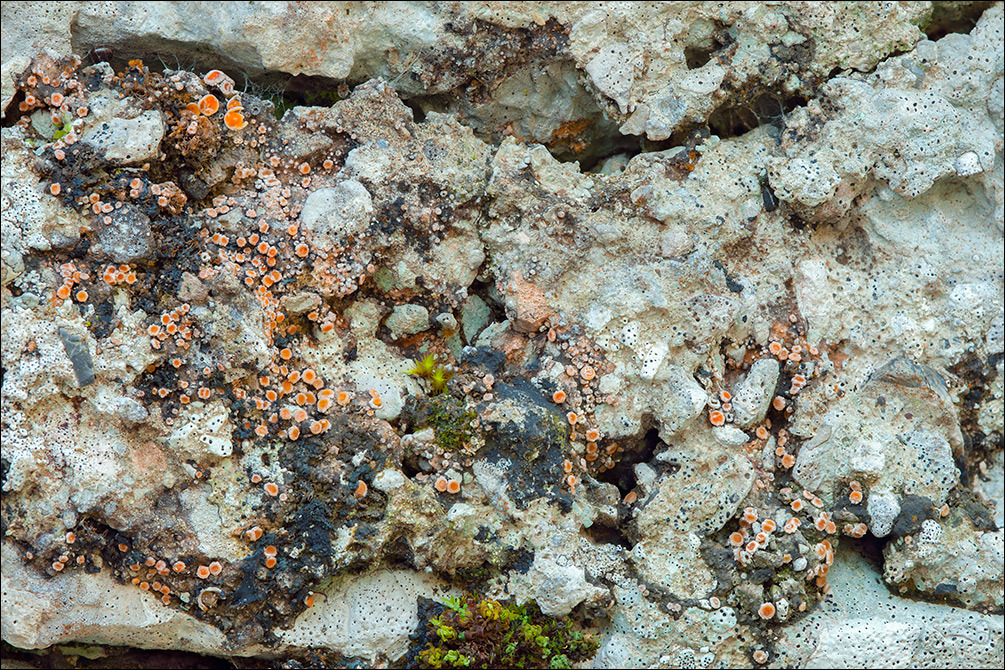
Slo.:? - syn.: Gyalecta cupularis (Hedw.) Schaer., Lecidea cupularis (Hedw.) Ach., Cappellettia cupularis (Hedw.) Tomas. & Cif. - Habitat: narrow canyon; stony, vertical, calcareous, manmade supporting wall; north aspect; very humid place with no sun most of the year; in total shade; about 1.5 m above the mountain stream; exposed to direct rain; average precipitations ~ 3.000 mm/year, average temperature 8-10 deg C, elevation 470 m 1.530 feet), alpine phytogeographical region.Substratum: calcareous rocks of a vertical wall of a bridge over a mountain stream.Comments: Gyalecta jenensis is a quite common but nice small jewel among crustose, saxicolous (growing on rocks) lichens. It has waxy-looking, from pale or vividly yellow to deep orange apothecia with whitish, usually cracked to segments margins. The inconspicuous thallus is grayish with sometimes pink tint but often covered by dark layer of cyanobacteria, which makes its appearance black (Ref.:1). It is often found together with Trentepohlia aurea, an orange filamentous algae capable to live outside water (see orange tufts on pictures 11b and 12b). The photobiont of Gyalecta jenensis is also Trentepohlia algae. This species was photographed at this place almost exactly ten years ago. Ref.:(1) I.M. Brodo, S.D. Sharnoff, S.Sharnoff, Lichens of North America, Yale Uni. Press (2001), p 329.(2) V. Wirth, R. Duell, Farbatlas Flechten und Moose, Ulmer, (2000), p 410.(3) C.W.Smith, et all, The lichens of Great Britain and Ireland,The British Lichen Society (2009), p 255.(4) F.S. Dobson, Lichens, The Richmonds Publishing Ca.LTD (2005), p 183.(5) http://www.aphotoflora.com/algae_trentepohlia_aurea_orange.html (Trentepohlia aurea) (accessed Feb. 12. 2018)
-
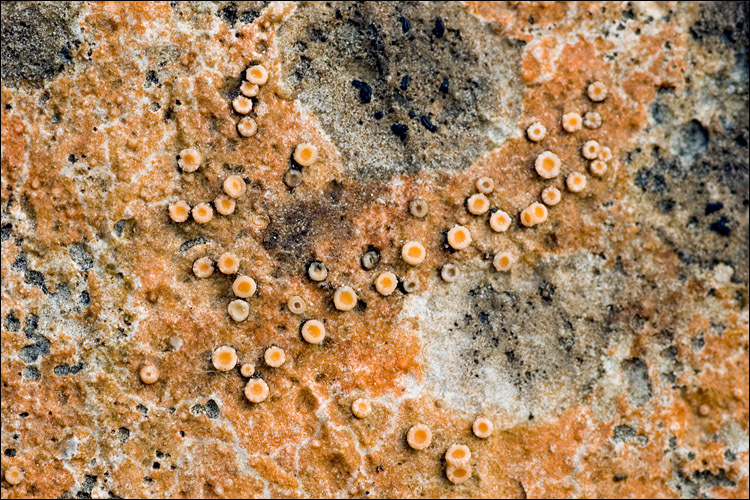
Half dry conditions. Eventually Gyalecta leucaspis? According to Wirth a very rare species for Germany. Pruegger et all. 'Alphabetical list of lichenized fungi for the six phytogeographical regions of Slovenia' has this species listed. G. leucaspis has vividly pink to light orange thallus and its apothecia rim disintegrate into 5-10 radial sections when old (Wirth, 1995). This corresponds well to my pictures. However, I can not find thick gray-white pruina on apothecia which is also a typical character for G. leucapsis. On the other hand, in literature and on web I have never found mentioning vivid orange as a possible thallus color of G. jenensis. G. jenensis is quite common here and also a possibility. Observing spores would resolve the dilemma. Habitat: Road scarp rocks of a dirt road, humid shady place, mixed forest and grassland around, no insolation during winter months, often wet, north oriented, 1.5 mm off the road level, exposed to precipitations, precipitations ~3.000 mm/year, average temperature 7-9 deg C, elevation 400 m (1.300 feet), alpine phytogeographical region. Substratum: vertical calcareous rock surface. Ref.: http://members.chello.at/johannes.pruegger/uni/slovenia/ , Wirth, (1995), Die Flechten Baden-Wuerttembergs, Ulmer, Vol.1., p410, Brodo, Sharnoff, Sharnoff (2001), Lichens of North Ameria, Yale Uni.Press, p329.
-
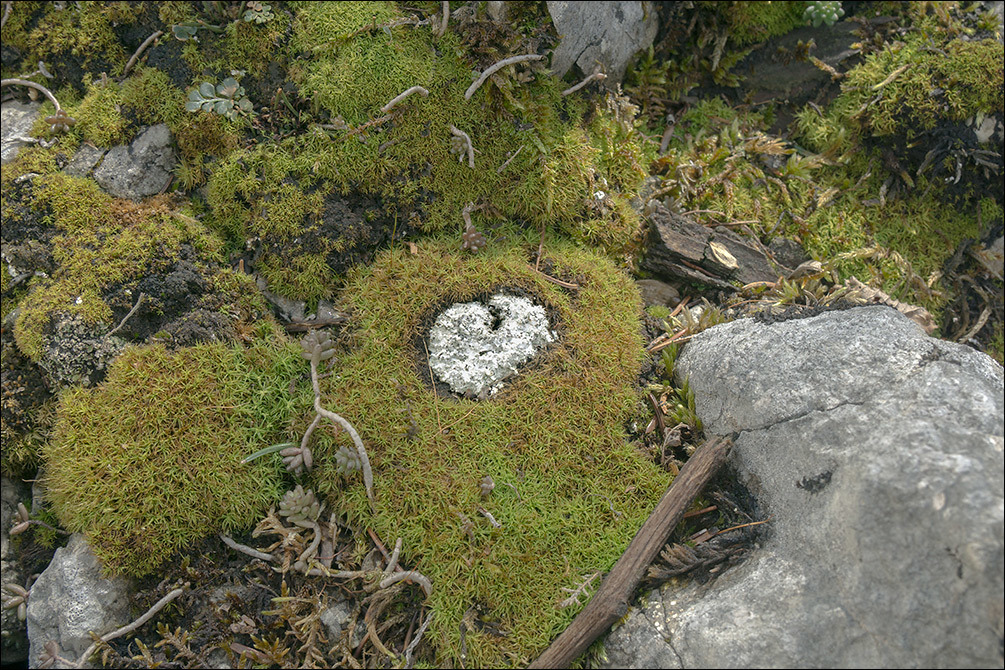
Slo.: ? - syn.: Diploschistes bryophilus f. parasitica (Sommerf.) Servt, Diploschistes lichenicola (Mont. & Fr.) Vain., Diploschistes scruposus f. bryophilus (Ehrh.) Oxner, Urceolaria scruposa f. parasitica (Sommerf.) Arnold - Habitat: Slightly inclined mountain slope, south aspect; a patch of stony grassland surrounded by trees and bushes (former pastures), Ostrya carpinifolia and Corylus avellana dominant; calcareous, skeletal, colluvial ground; full sun, relatively warm, dry and open place; exposed to direct rain; average precipitations ~ 3.000 mm/year, average temperature 7-9 deg C, elevations 615 m (2.020 feet), alpine phytogeographical region. Substratum: on thallus and podetia of Cladonia cf. pocillum, soil and mosses. Comment: Diploschistes muscorum is an interesting, cosmopolitan lichen living on ground. When young it parasitizes other lichens of Cladonia pyxidata group (Wirth 1995), especially Cladonia rangiformis and Cladonia pocillum (Dobson 2005). In this observation the host seems to be Cladonia pocillum. It gradually incorporates the algae of the host in its own thallus (Brodo 2001) and thus kill it. When mature it becomes free-living on mosses and ground without help of parasitism. It can grow to considerable sizes. This observation shows small, young specimens, max a few cm in diameter. Picture 3 shows a young specimen just becoming fertile, where lowest, outer squamules of the host are still alive and green. Picture 5c shows a podetium of the host thinly overgrown with Diploschistes muscorum thallus. Picture 2 shows an older specimen where no parts of the host can be seen directly, however, the shape of the thallus still resembles to some extent original shape of the Cladonia squamules. Later there is no more resemblance on Cladonia. Growing scattered. Several specimens found in the vicinity. Chemical reaction on thallus K-. Photographed in damp conditions. Ref.: (1) V. Wirth, Die Flechten Baden-Wrttembergs, Teil.1., Ulmer (1995), p 379. (2) I.M. Brodo, S.D. Sharnoff, S.Sharnoff, Lichens of North America, Yale Uni. Press (2001), p 304. (3) http://lichenportal.org/portal/taxa/index.php?taxon=52885 (accessed March 20. 2018) (4) F.S. Dobson, Lichens, The Richmonds Publishing Ca.LTD (2005), p 166. (5) C.W.Smith, et all, The lichens of Great Britain and Ireland,The British Lichen Society,(2009), p 380. (6) P.L. Nimis, Image archive of ITALIC, Dryades Project http://dbiodbs.units.it/carso/chiavi_pub52 (accessed March 20. 2018)
-
Slo.: ? - Habitat: Mixed wood, near a stream, humid and shaded place, protected from direct rain by tree canopies, precipitations ~3.000 mm/year, average temperature 7-9 deg C, elevation 630 m (2.100 feet), alpine phytogeographical region. Substratum: Bark of a fallen trunk of Fagus sylvatica
-
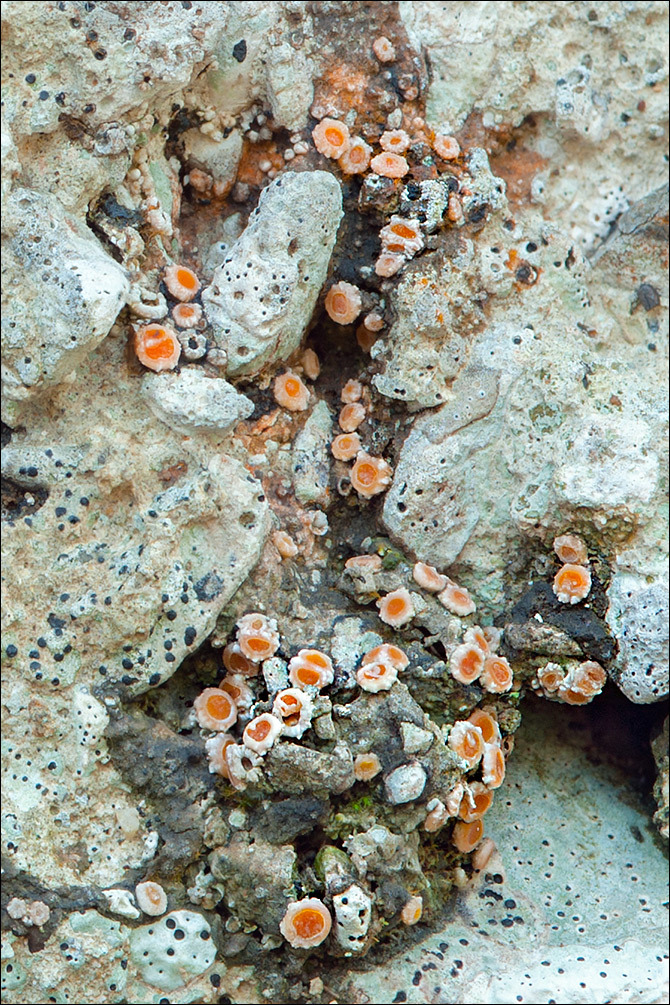
Slo.:? - syn.: Gyalecta cupularis (Hedw.) Schaer., Lecidea cupularis (Hedw.) Ach., Cappellettia cupularis (Hedw.) Tomas. & Cif. - Habitat: narrow canyon; stony, vertical, calcareous, manmade supporting wall; north aspect; very humid place with no sun most of the year; in total shade; about 1.5 m above the mountain stream; exposed to direct rain; average precipitations ~ 3.000 mm/year, average temperature 8-10 deg C, elevation 470 m 1.530 feet), alpine phytogeographical region. Substratum: calcareous rocks of a vertical wall of a bridge over a mountain stream. Comments: Gyalecta jenensis is a quite common but nice small jewel among crustose, saxicolous (growing on rocks) lichens. It has waxy-looking, from pale or vividly yellow to deep orange apothecia with whitish, usually cracked to segments margins. The inconspicuous thallus is grayish with sometimes pink tint but often covered by dark layer of cyanobacteria, which makes its appearance black (Ref.:1). It is often found together with Trentepohlia aurea, an orange filamentous algae capable to live outside water (see orange tufts on pictures 11b and 12b). The photobiont of Gyalecta jenensis is also Trentepohlia algae. This species was photographed at this place almost exactly ten years ago. Ref.: (1) I.M. Brodo, S.D. Sharnoff, S.Sharnoff, Lichens of North America, Yale Uni. Press (2001), p 329. (2) V. Wirth, R. Duell, Farbatlas Flechten und Moose, Ulmer, (2000), p 410. (3) C.W.Smith, et all, The lichens of Great Britain and Ireland,The British Lichen Society (2009), p 255. (4) F.S. Dobson, Lichens, The Richmonds Publishing Ca.LTD (2005), p 183. (5) http://www.aphotoflora.com/algae_trentepohlia_aurea_orange.html (Trentepohlia aurea) (accessed Feb. 12. 2018)
-
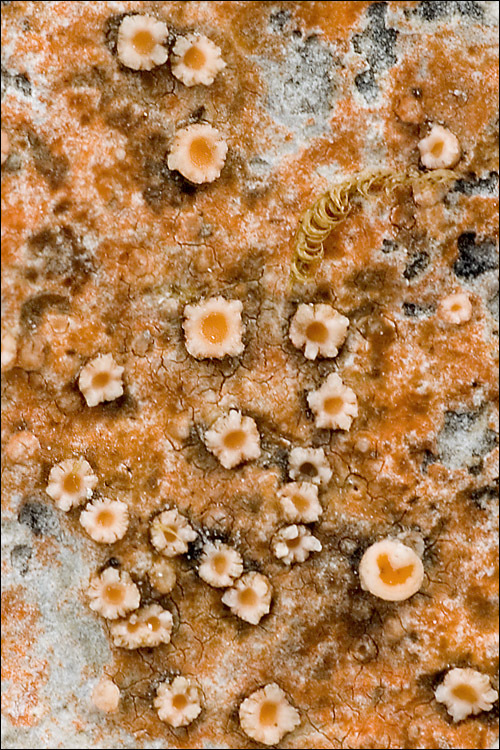
Half dry conditions. Eventually Gyalecta leucaspis? According to Wirth a very rare species for Germany. Pruegger et all. 'Alphabetical list of lichenized fungi for the six phytogeographical regions of Slovenia' has this species listed. G. leucaspis has vividly pink to light orange thallus and its apothecia rim disintegrate into 5-10 radial sections when old (Wirth, 1995). This corresponds well to my pictures. However, I can not find thick gray-white pruina on apothecia which is also a typical character for G. leucapsis. On the other hand, in literature and on web I have never found mentioning vivid orange as a possible thallus color of G. jenensis. G. jenensis is quite common here and also a possibility. Observing spores would resolve the dilemma. Habitat: Road scarp rocks of a dirt road, humid shady place, mixed forest and grassland around, no insolation during winter months, often wet, north oriented, 1.5 mm off the road level, exposed to precipitations, precipitations ~3.000 mm/year, average temperature 7-9 deg C, elevation 400 m (1.300 feet), alpine phytogeographical region. Substratum: vertical calcareous rock surface. Ref.: http://members.chello.at/johannes.pruegger/uni/slovenia/ , Wirth, (1995), Die Flechten Baden-Wuerttembergs, Ulmer, Vol.1., p410, Brodo, Sharnoff, Sharnoff (2001), Lichens of North Ameria, Yale Uni.Press, p329.
-
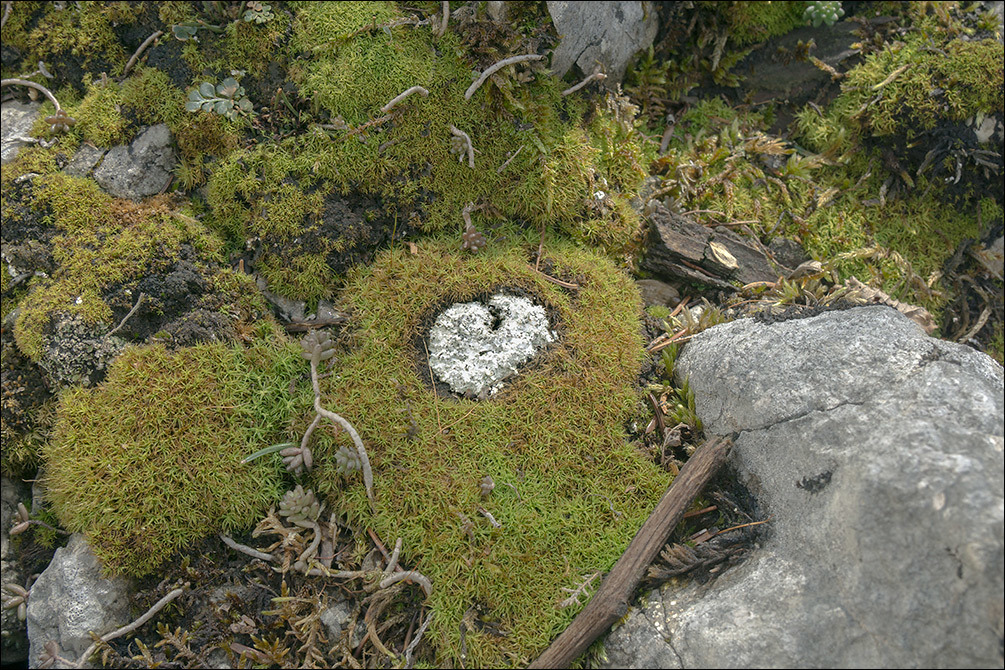
Slo.: ? - syn.: Diploschistes bryophilus f. parasitica (Sommerf.) Servt, Diploschistes lichenicola (Mont. & Fr.) Vain., Diploschistes scruposus f. bryophilus (Ehrh.) Oxner, Urceolaria scruposa f. parasitica (Sommerf.) Arnold - Habitat: Slightly inclined mountain slope, south aspect; a patch of stony grassland surrounded by trees and bushes (former pastures), Ostrya carpinifolia and Corylus avellana dominant; calcareous, skeletal, colluvial ground; full sun, relatively warm, dry and open place; exposed to direct rain; average precipitations ~ 3.000 mm/year, average temperature 7-9 deg C, elevations 615 m (2.020 feet), alpine phytogeographical region. Substratum: on thallus and podetia of Cladonia cf. pocillum, soil and mosses. Comment: Diploschistes muscorum is an interesting, cosmopolitan lichen living on ground. When young it parasitizes other lichens of Cladonia pyxidata group (Wirth 1995), especially Cladonia rangiformis and Cladonia pocillum (Dobson 2005). In this observation the host seems to be Cladonia pocillum. It gradually incorporates the algae of the host in its own thallus (Brodo 2001) and thus kill it. When mature it becomes free-living on mosses and ground without help of parasitism. It can grow to considerable sizes. This observation shows small, young specimens, max a few cm in diameter. Picture 3 shows a young specimen just becoming fertile, where lowest, outer squamules of the host are still alive and green. Picture 5c shows a podetium of the host thinly overgrown with Diploschistes muscorum thallus. Picture 2 shows an older specimen where no parts of the host can be seen directly, however, the shape of the thallus still resembles to some extent original shape of the Cladonia squamules. Later there is no more resemblance on Cladonia. Growing scattered. Several specimens found in the vicinity. Chemical reaction on thallus K-. Photographed in damp conditions. Ref.: (1) V. Wirth, Die Flechten Baden-Wrttembergs, Teil.1., Ulmer (1995), p 379. (2) I.M. Brodo, S.D. Sharnoff, S.Sharnoff, Lichens of North America, Yale Uni. Press (2001), p 304. (3) http://lichenportal.org/portal/taxa/index.php?taxon=52885 (accessed March 20. 2018) (4) F.S. Dobson, Lichens, The Richmonds Publishing Ca.LTD (2005), p 166. (5) C.W.Smith, et all, The lichens of Great Britain and Ireland,The British Lichen Society,(2009), p 380. (6) P.L. Nimis, Image archive of ITALIC, Dryades Project http://dbiodbs.units.it/carso/chiavi_pub52 (accessed March 20. 2018)
-
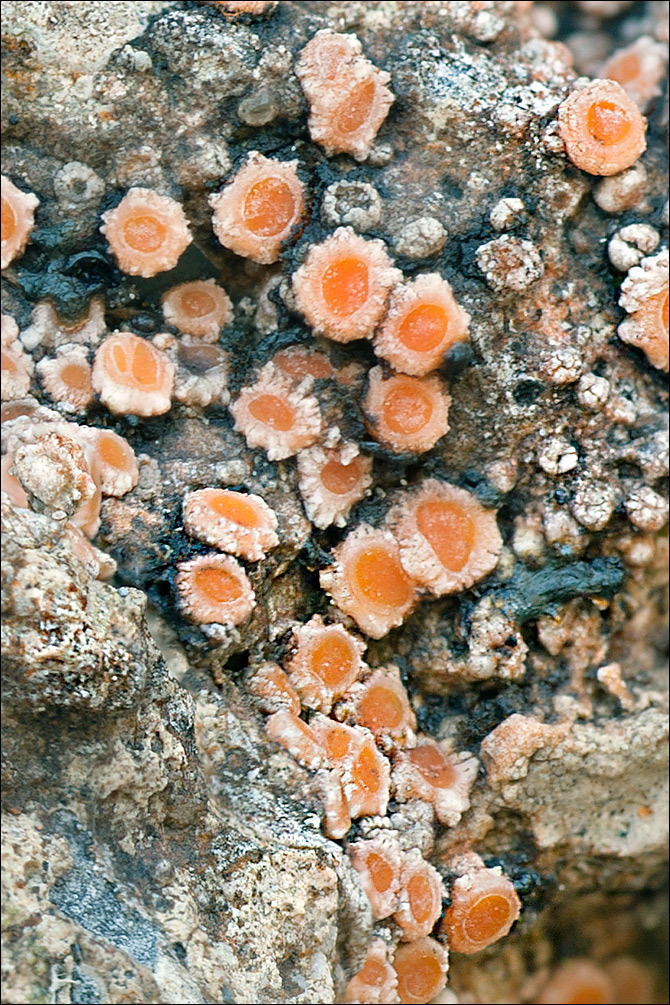
Slo.:? - syn.: Gyalecta cupularis (Hedw.) Schaer., Lecidea cupularis (Hedw.) Ach., Cappellettia cupularis (Hedw.) Tomas. & Cif. - Habitat: narrow canyon; stony, vertical, calcareous, manmade supporting wall; north aspect; very humid place with no sun most of the year; in total shade; about 1.5 m above the mountain stream; exposed to direct rain; average precipitations ~ 3.000 mm/year, average temperature 8-10 deg C, elevation 470 m 1.530 feet), alpine phytogeographical region. Substratum: calcareous rocks of a vertical wall of a bridge over a mountain stream. Comments: Gyalecta jenensis is a quite common but nice small jewel among crustose, saxicolous (growing on rocks) lichens. It has waxy-looking, from pale or vividly yellow to deep orange apothecia with whitish, usually cracked to segments margins. The inconspicuous thallus is grayish with sometimes pink tint but often covered by dark layer of cyanobacteria, which makes its appearance black (Ref.:1). It is often found together with Trentepohlia aurea, an orange filamentous algae capable to live outside water (see orange tufts on pictures 11b and 12b). The photobiont of Gyalecta jenensis is also Trentepohlia algae. This species was photographed at this place almost exactly ten years ago. Ref.: (1) I.M. Brodo, S.D. Sharnoff, S.Sharnoff, Lichens of North America, Yale Uni. Press (2001), p 329. (2) V. Wirth, R. Duell, Farbatlas Flechten und Moose, Ulmer, (2000), p 410. (3) C.W.Smith, et all, The lichens of Great Britain and Ireland,The British Lichen Society (2009), p 255. (4) F.S. Dobson, Lichens, The Richmonds Publishing Ca.LTD (2005), p 183. (5) http://www.aphotoflora.com/algae_trentepohlia_aurea_orange.html (Trentepohlia aurea) (accessed Feb. 12. 2018)

